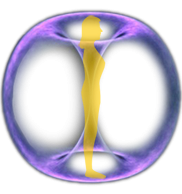Structural Integration is an intelligent, thorough method of bodywork based on a series of
ten sessions developed by Dr. Ida P. Rolf, Ph.D. In Structural Integration, the center of gravity of the major body segments is organized around a central vertical “Line.” Balancing a person’s structural alignment helps their body move and function with greater ease. As the body aligns back toward its original symmetry, gravity becomes an uplifting energizing force. Imagine a sturdy, resilient body with a strong dynamic energy field, a body and mind that can bend with stress and spring back with ease.
A Structural Integration practitioner removes patterns of adhered, twisted strain in the connective tissues that result when stress becomes internalized. Rotation patterns create pain and inflammation, and restrict energy flow. You may have experienced the problem of trying to work out on a twisted ankle, knee or hip. It’s best to strengthen and exercise healthy, balanced soft tissue; not short, twisted strain patterns that limit range of motion and pull tissues, joints, and bones out of alignment.
Rotation patterns are common. They can affect the extremities, core, or both. Perhaps you’ve noticed that one of your legs is shorter than the other. This is often the sign of a rotation pattern if that leg is not anatomically longer. Twisting patterns of strain contribute to sciatica, scoliosis, and disc problems. Core level muscles that attach into the spine, weave their way into the intervertebral discs. When those muscles twist, they can cause wear and tear in the discs that contribute to herniation and bulging. If the discs remain intact, and the strain pattern is removed, the discs may be able to heal and the vertebrae will have a better chance of staying in alignment.
Rotation problems also affect the autonomic nervous system, causing the fright/flight sympathetic nervous system response. Emotional trauma can “twist a person up in knots.” As the spine and rib cage twist, the autonomic nerves along both sides of the spine may become affected, which can contribute to anxiety, depression, and panic attacks. A client of mine who had a great loss in his family, experienced that level of anxiety. His panic attacks subsided when we cleared the rotation out of the core of his body. The results of Structural Integration are as varied as the people undergoing the process. Dr. Rolf commented on the effect of mental and emotional well being related to the work.
She said, “There is an ongoing psychological change as well toward balance, toward serenity, toward a more whole person. The whole person evidences a more apparent, more potent psychic development.” Dr. Ida Rolf continued, “Some individuals may perceive their losing fight with gravity as a sharp pain in their back, others as the unflattering contour of their body, others as a constant fatigue, yet others as an unrelentingly threatening environment. Those over forty may call it old age. And yet all these signals may be pointing to a single problem, so prominent in their own structure as well as others, that it has been ignored: they are off balance. They are at war with gravity.”
